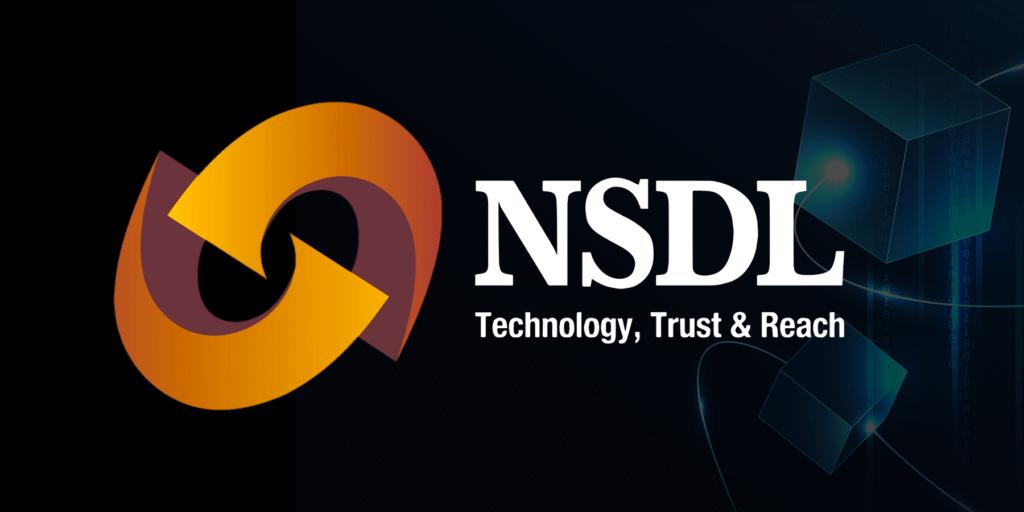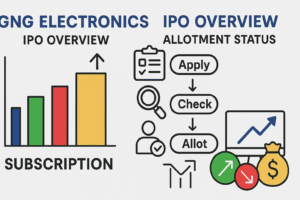
NSDL IPO 2025: India’s Largest Depository Goes Public
Comprehensive analysis of National Securities Depository Limited’s upcoming public offering
📋 Table of Contents
NSDL IPO: The Market’s Most Anticipated Offering
The National Securities Depository Limited (NSDL) is set to make its debut on the Indian stock exchanges with what promises to be one of the most significant IPOs of 2025. As India’s largest and oldest depository, NSDL’s public listing marks a historic milestone in the country’s financial markets evolution.
Key IPO Highlights
- India’s first securities depository going public
- 100% Offer for Sale (OFS) – no fresh capital raising
- Expected to open on July 30, 2025
- Listing planned on BSE with potential NSE dual listing
- Major institutional shareholders divesting stakes
IPO Structure and Timeline
Offer Details
Issue Size: 5.72 crore equity shares
Face Value: ₹2 per share
Expected Price Band: ₹750-800 per share
Issue Type: 100% Offer for Sale
Key Dates
IPO Opens: July 30, 2025
IPO Closes: August 1, 2025
Allotment Date: August 4, 2025
Listing Date: August 6, 2025
Quota Distribution
QIB (Qualified Institutional Buyers): 50%
HNI (High Net Worth Individuals): 15%
Retail Investors: 35%
Market Intermediaries
Lead Manager: ICICI Securities Limited
Registrar: Link Intime India Private Limited
Listing Exchange: BSE (Primary)
About National Securities Depository Limited
Established in August 1996, NSDL pioneered the dematerialization revolution in Indian capital markets. As the country’s first securities depository, it transformed how investors hold and trade securities by introducing electronic storage and settlement systems.
NSDL serves as a crucial market infrastructure institution, providing comprehensive depository services that include maintaining ownership records, facilitating seamless transfers, and enabling efficient settlement of securities transactions. The organization has been instrumental in eliminating the risks associated with physical share certificates while significantly reducing settlement times.
Important Note
This is an Offer for Sale (OFS), meaning existing shareholders are selling their stakes to comply with regulatory requirements. The company will not receive any proceeds from this IPO.
Major Selling Shareholders
The IPO consists entirely of shares being sold by existing institutional shareholders. The selling shareholders include some of India’s most prominent financial institutions:
IDBI Bank Limited
Current Stake: 26%
Shares Offered: 2.22 crore shares
One of the founding promoters of NSDL
National Stock Exchange (NSE)
Current Stake: 24%
Shares Offered: 1.8 crore shares
India’s leading stock exchange
State Bank of India (SBI)
Shares Offered: Significant portion
India’s largest public sector bank
Other Major Sellers
Union Bank of India, HDFC Bank, and SUUTI (Specified Undertaking of Unit Trust of India)
Investment Analysis: Why NSDL Stands Out
Market Position and Competitive Advantages
NSDL’s dominance in the Indian depository market is undisputed. As India’s largest depository, it maintains a commanding position across multiple key metrics that demonstrate its market leadership and growth potential.
Competitive Strengths
- Market leader with ₹500 trillion in assets under custody
- Extensive network of 36,123 service centers across 2,000+ cities
- Serves over 3.15 crore active investors globally
- Pioneer in depository services with 29 years of experience
- Strong technology infrastructure supporting T+1 settlements
- Diversified revenue streams beyond core depository services
Financial Performance Highlights
NSDL has demonstrated consistent financial growth, reflecting the robust expansion of India’s capital markets and increasing retail participation in equity investments.
Revenue Growth
FY 2025: ₹1,535.19 crores
FY 2024: ₹1,365.71 crores
Growth Rate: +12.4%
Profitability
FY 2025 PAT: ₹343.12 crores
FY 2024 PAT: ₹275.45 crores
Growth Rate: +24.6%
Historical Performance
Revenue CAGR (FY21-23): Strong double-digit growth
Market Share: Dominant position in institutional segment
Business Model
Revenue Sources: Custody fees, transaction fees, and value-added services
Scalability: High operating leverage with growing market
Investment Rationale
Growth Drivers
Several structural factors support NSDL’s long-term growth prospects, making it an attractive investment opportunity for both institutional and retail investors.
Long-term Growth Catalysts
- Increasing financialization of Indian households
- Rising retail participation in equity markets
- Growing mutual fund and insurance penetration
- Expansion of corporate bond market
- Digital India initiatives supporting electronic transactions
- Potential for new product and service launches
Risk Factors
Like any investment, NSDL comes with certain risks that potential investors should carefully consider.
Key Investment Risks
Regulatory Risks: Heavy dependence on regulatory approvals and compliance requirements
Competition: Intense competition from CDSL, especially in retail segment
Market Dependency: Revenue closely linked to market volatility and trading volumes
Technology Risks: Need for continuous technology upgrades and cybersecurity measures
Valuation Analysis
At the expected price band of ₹750-800, NSDL’s valuation appears reasonable when compared to its listed peer CDSL and considering its market position and growth prospects.
Valuation Metrics
Expected Market Cap: ₹15,000-16,000 crores
P/E Ratio: Competitive with sector averages
Price to Book: Reasonable for a financial services company
Peer Comparison
CDSL Comparison: Both companies serve different market segments
Market Position: NSDL’s institutional focus vs CDSL’s retail strength
NSDL vs CDSL: Understanding India’s Two Depositories
India’s securities market is supported by two major depositories: NSDL and CDSL. While both provide similar core services, they have distinct characteristics, market positions, and strategic focuses that investors should understand.
Comprehensive Comparison Table
| Parameter | NSDL | CDSL |
|---|---|---|
| Establishment Year | 1996 (First in India) | 1999 |
| Primary Stock Exchange | NSE (National Stock Exchange) | BSE (Bombay Stock Exchange) |
| Market Share (Assets Under Custody) | Higher institutional market share | Leading in retail accounts (76%) |
| Active Accounts (2024) | 3.91 crore accounts | 11.56 crore accounts |
| Assets Under Custody | ₹500+ trillion | Lower than NSDL |
| Service Centers | 36,123+ centers | 21,434+ centers |
| Account Number Format | IN + 14 digits | 16 digits only |
| Listing Status | Upcoming IPO (2025) | Listed since 2017 |
| Promoter Organizations | NSE, IDBI Bank, UTI, SBI | BSE, SBI, HDFC Bank, BoB |
| Revenue Growth (Recent) | 18.4% CAGR (FY20-24) | 34.4% CAGR (FY20-24) |
| Target Segment | Institutional & HNI focused | Retail investor focused |
| Special Features | Advanced settlement systems, e-voting | E-locker, retail-friendly services |
Market Dynamics and Competition
The competition between NSDL and CDSL reflects the broader evolution of India’s capital markets, with each depository developing distinct competitive advantages and market positioning strategies.
NSDL’s Strengths
Institutional Dominance: Strong presence in institutional and high-value transactions
Technology Leadership: Pioneer in dematerialization and advanced settlement systems
Market Infrastructure: Extensive network supporting large-scale operations
CDSL’s Advantages
Retail Focus: Market leader in retail investor accounts with 76% market share
Rapid Growth: Faster revenue growth driven by retail expansion
Listing Premium: Already listed, providing liquidity and transparency
Investment Perspective: NSDL vs CDSL
For investors, both NSDL and CDSL represent different investment themes within the broader story of India’s capital market growth. NSDL offers exposure to institutional market growth and established market leadership, while CDSL provides access to the retail democratization trend.
Why Invest in NSDL?
- Established market leader with proven track record
- Dominant position in high-value institutional transactions
- Strong technological infrastructure and innovation capability
- Diversified revenue streams and stable business model
- First-mover advantage in Indian depository services
Market Outlook
The Indian depository market is expected to grow significantly, driven by increasing financialization, rising retail participation, and expanding corporate issuances. Both NSDL and CDSL are well-positioned to benefit from these trends, though their growth trajectories may differ based on their strategic focus areas.
According to industry projections, the depository market is expected to grow at a 12% CAGR between FY2023-2027, providing ample growth opportunities for both depositories.
↑ Back to TopFinancial Performance & Market Charts
NSDL Financial Highlights
Revenue Trend
FY 2021: ₹467.57 crores
FY 2023: ₹1,021.99 crores
FY 2025: ₹1,535.19 crores
CAGR: 34.2%
Profitability Growth
FY 2021 PAT: ₹188.57 crores
FY 2023 PAT: ₹234.81 crores
FY 2025 PAT: ₹343.12 crores
Growth: +82% over 4 years
Key Ratios
Profit Margin: High and improving
ROE: Strong return metrics
Debt-to-Equity: Conservative capital structure
Business Metrics
Active Accounts: 3.91 crore
Service Centers: 36,123+
Geographic Reach: 2,000+ cities
Global Presence: 186 countries
Revenue Composition Analysis
Market Growth Projections
The Indian depository market is experiencing unprecedented growth, driven by several structural factors that position both NSDL and CDSL for continued expansion.
Growth Drivers
- Retail investor base growing at 25%+ annually
- Mutual fund AUM expansion supporting custody growth
- Corporate bond market development
- Insurance and pension fund growth
- Digital payment and settlement infrastructure advancement
Frequently Asked Questions
NSDL (National Securities Depository Limited) is India’s largest and oldest securities depository, established in 1996. It holds securities in electronic form and facilitates trading and settlement. The IPO is significant because NSDL is a critical market infrastructure institution that has been privately held since inception. Its public listing will provide investors direct access to India’s depository business growth story.
While both are depositories, NSDL focuses more on institutional and high-value transactions with ₹500+ trillion in assets under custody. CDSL leads in retail accounts with 76% market share and 11.56 crore accounts. NSDL is associated with NSE, while CDSL works with BSE. NSDL account numbers start with ‘IN’ followed by 14 digits, while CDSL uses 16 digits only.
Key risks include regulatory dependency, intense competition from CDSL, market volatility affecting trading volumes, technology upgrade requirements, and the concentrated nature of the depository business. Additionally, this is an OFS, so the company won’t receive fresh capital for growth initiatives.
This is an Offer for Sale (OFS) required to comply with SEBI’s 15% ownership limit for Market Infrastructure Institutions (MIIs). Major shareholders like IDBI Bank (26% stake), NSE (24% stake), SBI, and others are divesting to meet regulatory requirements while providing public access to NSDL shares.
NSDL generates revenue through custody fees from issuers, transaction fees from depository participants, and annual maintenance charges. The company has shown strong growth with revenue increasing from ₹1,365.71 crores in FY24 to ₹1,535.19 crores in FY25. Growth is driven by increasing financialization, retail participation, and expanding corporate issuances.
Retail investors can apply through their broker’s platform using UPI or ASBA (Application Supported by Blocked Amount). The retail quota is 35% of the total issue. Investors need a demat account and can apply online through trading platforms or offline through application forms. Multiple applications using the same PAN are not allowed.
While listing performance depends on market conditions and investor demand, NSDL’s strong fundamentals, market leadership position, and the growing depository business could support positive listing performance. However, investors should note the 22% discount to grey market valuations mentioned in some reports, suggesting realistic pricing.
NSDL offers exposure to India’s capital market growth story with a stable, recurring revenue business model. The company benefits from increasing retail participation, mutual fund growth, and corporate bond market expansion. However, investors should consider the competitive landscape, regulatory environment, and their own risk tolerance before investing.
Investment Disclaimer
This analysis is for informational purposes only and should not be considered as investment advice. Potential investors should conduct their own research, consider their financial situation, and consult with qualified financial advisors before making investment decisions. IPO investments carry market risks, and past performance does not guarantee future results.








Post Comment